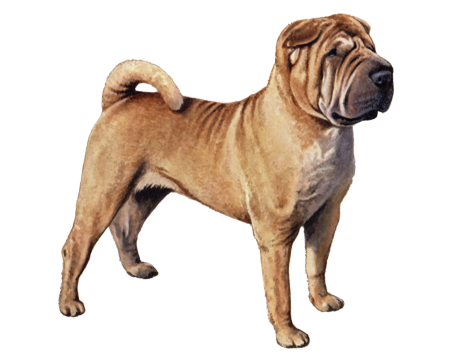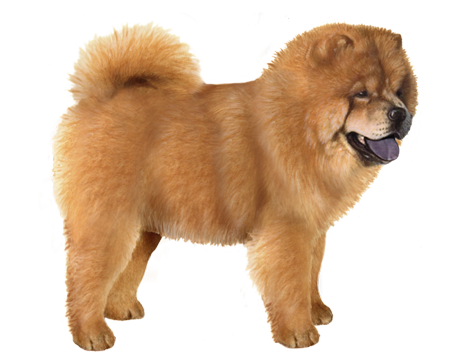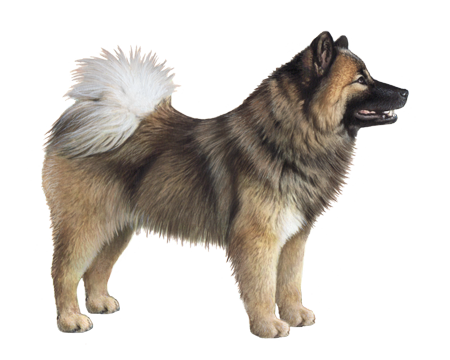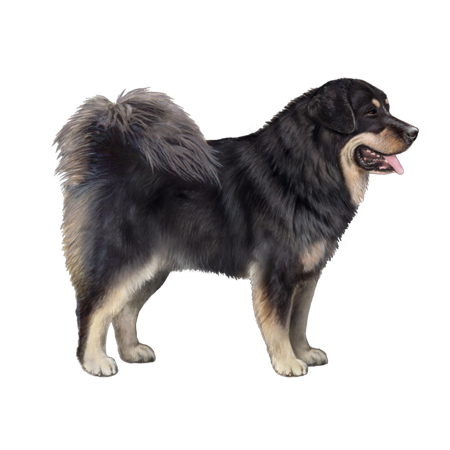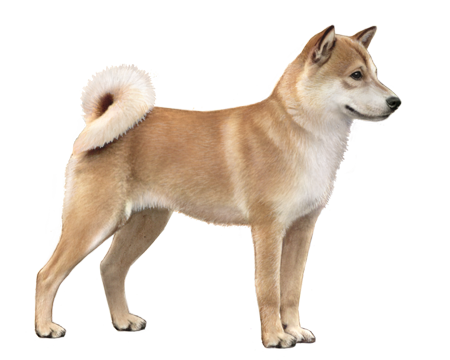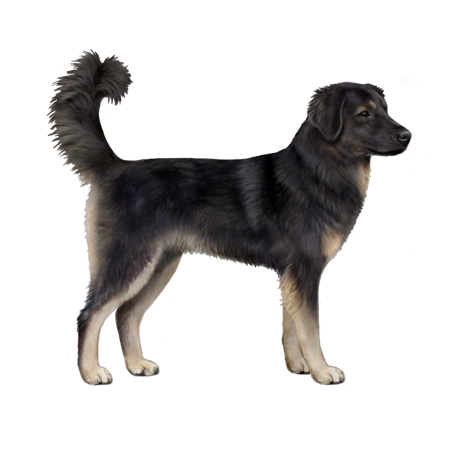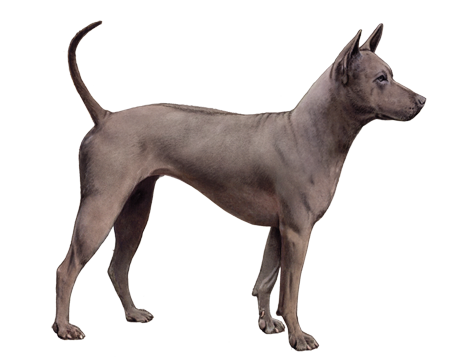
Alaskan Malamute
Alaskan Malamutes may be best known as sled dogs. But they're also adoring, playful animals. With the right training and socialization, the Malamute makes a great, hardworking family pet.
Interested in discovering if your dog is an Alaskan Malamute?
Check out Wisdom Panel's DNA tests.

Alaskan Malamute Traits
General Appearance
These powerful, muscular dogs have deep chests, broad shoulders, large heads, triangular ears, and large, furry tails.
Coat and Colouring
Malamutes have thick, coarse coats that come in several different colors—including black and white, blue-gray and white, gray and white, red and white, sable and white, silver and white, agouti and white, and pure white.
Distinctive Physical Traits
You can easily recognize an Alaskan Malamute by its wolf-like appearance and signature face mask (except when the dog is entirely white).
Alaskan Malamute Temperament
Outgoing, affectionate, and devoted companions, Alaskan Malamutes love people and are great with children. This breed enjoys curling up on the couch—but only after a lot of demanding exercise and stimulating activities.
As pack dogs, Malamutes typically do well with other dogs in the home. But they might not immediately get along with strange dogs. Alaskan Malamutes also have strong predatory instincts and may consider smaller animals as prey. So, take care to establish other pets as part of the family. Early socialization can also help with this.
Despite their size and imposing stature, Alaskan Malamutes are often too friendly to be effective guard dogs.


Alaskan Malamute History
As its name suggests, the Alaskan Malamute hails from Alaska. A distant relative of Siberian Huskies from Asia, Samoyeds from Russia, and the Greenland Dog, it's likely one of the oldest sled dog breeds in the Arctic.
Alaskan Malamutes descended from domesticated wolf-dogs that migrated alongside hunters crossing the Bering Strait into North America more than 4,000 years ago.
The name "Malamute" comes from an Alaskan Inuit tribe, Mahlemiut. With high strength and endurance, Malamutes have historically pulled sleds full of supplies across long distances. But they also made excellent hunting companions—distracting bears during hunts and finding seals using breathing holes.
During the gold rush, demand for sled dogs boomed. And people often mixed purebred Alaskan Malamutes with other dogs, nearly pushing the breed to extinction. Fortunately, these lovable pups survived.
In 1935, the original Kotzebue line of the Alaskan Malamute breed earned recognition from the American Kennel Club, which later added the M'Loot and Hinman lines to their breed registries. The current Alaskan Malamute gene pool includes dogs from all three lines.
Alaskan Malamute Care
Nutrition
Alaskan Malamutes require a high-quality dog food that is age-appropriate—whether it's commercially manufactured or homemade (with a veterinarian's supervision and approval). Look for foods designed for large, high-energy breeds. And keep in mind that dogs engaged in endurance activities like sledding or skijoring (when a dog pulls a person on skis) may require extra calories.
These highly active dogs aren't prone to weight issues. But it's important to monitor how much your Alaskan Malamute eats and reduce portions or restrict calories if your pup gains excess weight. Also, remember that giving too many treats in addition to regular meals can contribute to obesity.
Grooming
Daily grooming is required to keep your Malamute's thick, coarse coat looking its best. A metal comb and pin brush are the ideal tools for the job. Grooming is especially important for this breed because its waterproof fur often becomes matted, which can impact skin health.
Alaskan Malamutes blow their coats twice per year. During these times, you'll need to groom more frequently to manage your dog's undercoat. Bathing them with conditioner will also keep their coat from becoming too dry.
Finally, all dogs need their nails trimmed, ears cleaned, and teeth brushed regularly.
Exercise
Strong, active dogs, Alaskan Malamutes are members of the working dog group and require a lot of exercise. So, be prepared for long walks and off-leash play at fenced-in dog parks. Because without enough opportunities to burn off their energy and appease their working instincts, Alaskan Malamutes can become bored and destructive.
Enrolling Alaskan Malamutes in activities like agility, obedience trials, and weight-pulling competitions are other fun options. These athletic dogs also make excellent running partners and perfect companions for backpacking trips, competitive sledding, and skijoring.
Training
The Alaskan Malamute is an intelligent breed that responds well to positive, reward-based training. But these dogs can also be stubborn and willful. So, consistent, rigorous training is essential for raising a respectful, obedient dog.
Because Malamutes are pack animals, they must understand their place in the family hierarchy. Without adequate socialization and training, they may become dominant with other pets and kids—posing a risk due to their sheer size and strength.
Use toys and treats to capture this breed's attention. And remember that some behaviors, such as digging, are hardwired into Alaskan Malamutes and may be hard to eradicate—even with the best training.

Alaskan Malamute Genetic Health Conditions
-
Cone Degeneration (Discovered in the Alaskan Malamute)
Cone Degeneration (CD), also called "day-blindness" is an inherited eye disorder causing light-sensitivity (photophobia) and an inability to see in bright light.
-
Early-Onset Progressive Polyneuropathy (Discovered in the Alaskan Malamute)
Early-Onset Progressive Polyneuropathy is characterized by the dysfunction and breakdown of multiple nerve types, which causes generalized weakness, and related clinical signs.
-
Primary Ciliary Dyskinesia (Discovered in the Alaskan Malamute)
Primary ciliary dyskinesia (PCD) is a disorder that causes a defect in the formation of cilia, tiny hair-like projections, found on cells in the respiratory system, reproductive system, ear and nervous system. Clinical signs of PCD are recurrent infections of the respiratory tract and fertility problems.
Knowing if your Alaskan Malamute is a carrier or at-risk for these conditions can help you and your veterinarian plan for your pup's lifelong care. With Wisdom Panel™ Premium, you can get results for over 200 genetic health tests.
Breed Group
Asian and Oceanian
The Asian and Oceanian group is comprised of breeds whose origins lie in Asia, which have spread as far as Australia, the islands of the Pacific, and the Arctic. This group is possibly the most ancient of all breed groups and were bred for a variety of purposes, including guarding, hunting, and as draft dogs.
Resources
https://www.akc.org/dog-breeds/alaskan-malamute/
https://www.amcb.info/en/alaskan-malamute/origin-and-history/
http://alaskanmalamute.org/malamutes/breed-standard/
Reviewed 26 July 2020 by Cindy Elston, DVM, MPH





